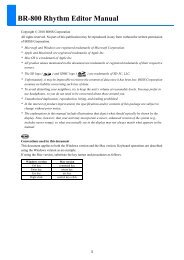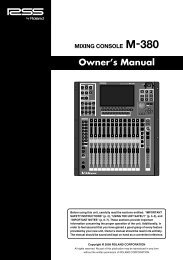GAIA Exploring Sound (PDF) - Roland Corporation Australia
GAIA Exploring Sound (PDF) - Roland Corporation Australia
GAIA Exploring Sound (PDF) - Roland Corporation Australia
Create successful ePaper yourself
Turn your PDF publications into a flip-book with our unique Google optimized e-Paper software.
Section 4<br />
Tempo Sync and Key Trigger<br />
Before we move on to some more powerful controllers on the<br />
<strong>GAIA</strong> we should mention yet another “secret” function; Key<br />
Trigger.<br />
As you know, by pressing the Shift key on either the <strong>GAIA</strong> or<br />
computer we can access more functions. The Amplifier Level<br />
becomes a Level Velocity Sensitivity (affects the volume<br />
dynamics.) The Cutoff becomes Envelope Velocity Sensitivity<br />
(affects the tone color). The Detune becomes a Pan control.<br />
Most importantly, the Tempo Sync becomes a Key Trigger<br />
control. Let’s discuss these two controls.<br />
Tempo Sync<br />
Initialize the Patch and raise the Pitch Depth in the LFO section<br />
to about 20. Now if you play a note you will hear a wide vibrato. If<br />
you then switch on the Tempo Sync, so that its light is red, you<br />
will hear a vibrato but at a different rate. This is because the rate<br />
is now being controlled by a master clock within the <strong>GAIA</strong>.<br />
example, that would mean we could synchronize the vibrato to<br />
an arpeggiator. We will discuss the arpeggiator in a later lesson.<br />
For now, with Tempo Sync switched off you will find that the Rate<br />
control sweeps smoothly over a range of vibrato rates. However,<br />
with Tempo Sync switched on the Rate control seems to step<br />
through the range. Try it. The rate control is definitely not<br />
sweeping smoothly as before.<br />
This is because it is now musically related to the master clock.<br />
This master clock, for example, may be ticking away at 120<br />
beats per minute. So now the Rate control can select intervals<br />
like; quarter note, eighth note, or eighth note triplet. This can be<br />
very useful for a range of musical styles, particularly for<br />
electronic dance music.<br />
This master clock can then determine the rate of the LFO, and<br />
the rate of other functions in the <strong>GAIA</strong> at the same time. For<br />
73

















